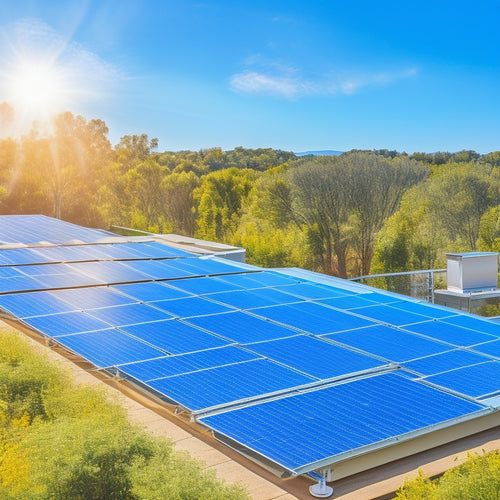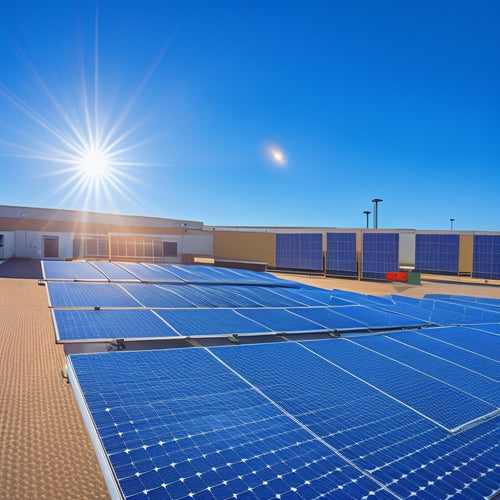
What Drives Global Adoption of Sustainable Power Systems
Share
Global adoption of sustainable power systems hinges on cost-effective solutions, technological advancements, and heightened environmental awareness. You'll find that renewable energy sources, such as solar and wind, have dramatically decreased in cost, making them financially attractive. This shift leads to lower energy bills and reduces reliance on fossil fuels, which are subject to price volatility. Additionally, advancements in energy storage and smart grid technologies enhance efficiency and reliability. Strong policy support further drives investments and creates jobs, promoting economic growth. To fully grasp the intricacies and benefits involved, you might consider exploring related developments in sustainable energy initiatives.
At a Glance
- Cost-effective energy solutions and significant savings on energy bills drive the transition to sustainable power systems.
- Economic benefits, including job creation and lower operational costs, enhance the appeal of renewable energy investments.
- Innovations in renewable technology, such as advanced solar panels and energy storage, improve efficiency and integration into existing systems.
- Environmental impact reduction through decreased carbon emissions and ecosystem protection motivates communities to adopt sustainable practices.
- Policies promoting sustainability and environmental justice ensure marginalized communities benefit, fostering inclusivity in energy transitions.
Cost-Effective Energy Solutions
When you consider the economic benefits of sustainability, it becomes clear that cost-effective energy solutions are crucial for both consumers and businesses.
Off-grid solar systems, in particular, offer energy independence, allowing households to reduce reliance on traditional power sources while also benefiting from renewable energy sources that are essential for sustainable electricity generation.
Innovations in renewable technology not only reduce operational costs but also drive job creation and economic growth.
Economic Benefits of Sustainability
Sustainability's economic benefits extend far beyond environmental preservation, often presenting persuasive cost-effective energy solutions that can enhance both individual and collective financial stability.
By shifting to renewable energy sources, you not only reduce your energy bills but also mitigate the volatility associated with fossil fuel prices. Studies show that sustainable investments yield significant returns, with solar and wind energy costs dropping by over 80% in the last decade, making them competitive with traditional energy sources.
Moreover, this change encourages green job creation, revitalizing the economy by generating millions of jobs in installation, maintenance, and manufacturing sectors.
For instance, the International Renewable Energy Agency reported that renewable energy jobs surged to over 11 million globally, showcasing a clear pathway toward economic advancement through sustainability.
Investing in energy efficiency technologies also maximizes your resources, leading to reduced operational costs for businesses and households alike.
Policies promoting sustainable practices not only pave the way for cleaner environments but also stimulate local economies.
As you adopt sustainability, you're not just protecting the planet; you're investing in a future where economic freedom and environmental health go hand in hand.
Innovations in Renewable Technology
Innovations in renewable technology are reshaping the environment of cost-effective energy solutions, making it easier than ever for you to utilize clean energy. As you investigate these advancements, you'll find that they not only enhance energy efficiency but also promote grid integration through smart grids. Technologies in energy storage, such as advanced batteries, enable you to capture solar innovations and wind advancements effectively.
Here's a quick overview of some key innovations:
| Technology Type | Recent Developments |
|---|---|
| Solar Innovations | Bifacial solar panels |
| Wind Advancements | Turbine efficiency gains |
| Energy Storage | Solid-state batteries |
Moreover, biomass technologies and geothermal solutions are gaining traction, providing additional options for sustainable materials. Hydropower developments are also changing, making it possible to generate energy with minimal environmental impact. These innovations create an environment where you have more choices and greater freedom to adopt renewable energy sources. By embracing these technologies, you can contribute to a sustainable future while enjoying the economic benefits of lower energy costs.
Environmental Impact Reduction
Reducing environmental impact is critical for sustainable power systems, particularly through decreased carbon emissions and biodiversity preservation efforts.
You'll find that implementing policies aimed at lowering emissions can greatly enhance air quality and public health, while also protecting ecosystems.
Decreased Carbon Emissions
As the world grapples with the urgent need to combat climate change, the change to sustainable power systems plays an essential role in decreasing carbon emissions. By adopting carbon reduction strategies such as shifting to renewable energy sources like wind, solar, and hydroelectric power, you can greatly lower greenhouse gas emissions.
These strategies not only help mitigate climate change but also encourage energy independence and economic resilience.
The integration of emission control technologies further enhances this change. Technologies such as carbon capture and storage (CCS) allow for the continued use of fossil fuels while minimizing their environmental impact. By implementing policies that support these innovations, governments can create an enabling environment for businesses and individuals to invest in sustainable solutions.
Moreover, data reveals that countries actively pursuing these approaches are already witnessing measurable declines in carbon emissions. For instance, nations that have committed to net-zero goals are leveraging sustainable power systems as a cornerstone of their climate action plans.
Biodiversity Preservation Efforts
The shift to sustainable power systems not only addresses carbon emissions but also has significant implications for biodiversity preservation. When you welcome renewable energy sources, you help reduce habitat destruction, a key driver of biodiversity loss. The integration of sustainable technologies encourages habitat restoration, allowing ecosystems to recover and thrive.
Evidence shows that areas powered by renewable energy systems often experience enhanced ecosystem services, such as improved water quality and increased pollinator populations. For instance, wind farms can coexist with agricultural land, promoting biodiversity while providing clean energy.
Policies focused on sustainable power can incentivize landowners to engage in habitat restoration projects, further reinforcing biodiversity. By supporting programs that prioritize ecosystem services, you're not just advocating for cleaner energy—you're contributing to a comprehensive approach that benefits both people and nature.
Moreover, investing in green technologies can create a ripple effect, nurturing community engagement and awareness about the importance of preserving biodiversity. As you champion these initiatives, you're laying the groundwork for a more resilient and sustainable future, one where freedom and environmental stewardship go hand in hand.
Key Advantages of Sustainable Systems
When you consider sustainable power systems, it's clear they offer significant advantages, particularly in environmental impact reduction and economic cost savings.
By shifting to these systems, you're not only minimizing harmful emissions but also potentially lowering your energy costs in the long run.
This change towards renewable energy independence enhances financial stability and allows homeowners to redirect resources to essential areas of life.
This dual benefit highlights why policy shifts toward sustainable energy solutions are critical for both economic and environmental health.
Environmental Impact Reduction
Reducing environmental impact is a primary advantage of sustainable power systems, showcasing their crucial role in combating climate change. By leveraging technological advancements, these systems facilitate an energy shift that minimizes greenhouse gas emissions, directly addressing the urgent climate crisis.
You'll find that effective policy structures and regulatory incentives are essential for promoting sustainable practices, encouraging widespread adoption among businesses and communities alike.
Public awareness plays a crucial role in nurturing community engagement, guaranteeing that citizens understand the importance of sustainable power systems. This heightened awareness not only drives individual action but also influences policymakers to prioritize environmental justice in resource management.
By integrating equity into energy policies, we can guarantee that marginalized communities benefit from sustainable initiatives, reducing their vulnerability to climate impacts.
As you consider the broader implications of sustainable power systems, recognize that their adoption contributes considerably to the reduction of environmental harm.
The combination of community engagement and strong policy structures creates a pathway toward a more sustainable future, enabling individuals and communities to take charge of their energy needs while promoting a healthier planet for all.
Economic Cost Savings
Adopting sustainable power systems not only benefits the environment but also leads to significant economic cost savings for individuals and communities. By investing in renewable energy technologies, you can reduce monthly utility bills and take advantage of incentive programs designed to ease the financial burden of these changes.
Market trends indicate that as more consumers become aware of sustainable options, the demand for green technologies increases, driving down costs through economies of scale.
Furthermore, strong policy structures support these shifts, ensuring that your financial investments yield long-term returns. With growing consumer awareness and corporate responsibility, companies are increasingly focused on sustainable practices, often resulting in lower operational costs.
Green financing options make it easier for you to access the capital needed for these advancements. Technological advancements in energy efficiency continue to enhance the viability of sustainable power systems, making them more affordable and accessible.
As you adopt these systems, you're not just contributing to a healthier planet; you're also positioning yourself to benefit from ongoing savings and a more resilient financial future. By aligning with these trends, you're taking control of your energy costs and supporting a sustainable economy.
Selecting Based on Energy Source
When you're choosing an energy source for sustainable power systems, consider the long-term impacts of renewable energy options versus fossil fuel alternatives.
Data shows that investing in renewables can greatly reduce greenhouse gas emissions and enhance energy security.
Additionally, home energy storage systems can further strengthen your reliance on renewable energy by providing a reliable backup power supply and optimizing energy usage.
Renewable Energy Sources
In the quest for sustainable power systems, selecting renewable energy sources involves careful consideration of various factors, including availability, efficiency, and environmental impact.
You'll find that solar energy stands out due to its widespread availability and decreasing costs, making it a popular choice. Wind power, with its impressive efficiency in certain regions, complements solar by providing energy when sunlight is scarce.
Hydroelectric systems offer reliability but require careful assessment of ecological impacts. Geothermal energy presents a stable option, tapping into the Earth's heat, while biomass utilization can recycle waste into energy, promoting a circular economy.
Tidal energy, though still developing, holds promise for coastal communities.
Energy storage solutions, such as batteries, are essential to mitigate the intermittent nature of these sources, ensuring a consistent supply. Community solar initiatives enable local participation, allowing access to renewable energy for those unable to install individual systems.
Microgrid solutions enhance resilience, allowing communities to operate independently from centralized systems.
Effective renewable policies will be significant in accelerating adoption. By prioritizing these sources, you're contributing to a cleaner, more sustainable energy future, ultimately enjoying the freedoms that come with energy independence and environmental stewardship.
Fossil Fuel Alternatives
As the world increasingly adopts renewable energy sources, evaluating fossil fuel alternatives becomes vital for a sustainable energy environment. You should consider a variety of options, including geothermal energy, which utilizes the Earth's internal heat, providing a consistent energy supply.
Biofuel advancements are also promising, converting organic materials into energy and reducing greenhouse gas emissions. Hydrogen production, particularly green hydrogen, offers another pathway by utilizing renewable energy for electrolysis, allowing for versatile applications, including fueling electric vehicles.
Additionally, advancements in energy storage solutions are significant, enabling the effective use of intermittent sources like solar technologies and wind energy. Tidal energy presents an underutilized resource, capturing the kinetic energy of ocean tides, while smart grids enhance energy efficiency by optimizing electricity distribution and consumption.
It's important to integrate these alternatives into a thorough energy policy that prioritizes sustainability, ensuring a strong shift away from fossil fuels. By embracing these alternatives, you'll contribute to a more resilient and freedom-oriented energy future, enabling communities and nurturing economic growth without compromising environmental integrity.
Long-Term Energy Security
When considering long-term energy security, energy independence offers significant advantages for your nation's stability and economic resilience.
By investing in domestic energy sources, you reduce reliance on foreign supplies, which can be volatile and subject to geopolitical tensions.
This strategic shift not only enhances your energy security but also promotes job creation and technological innovation within your local economy.
Energy Independence Benefits
Energy independence offers significant long-term security by reducing vulnerability to global market fluctuations and geopolitical tensions. When you prioritize energy autonomy, you lessen reliance on imported fossil fuels, which can fluctuate in price due to external factors.
By investing in sustainable power systems, you create a more stable energy supply that supports economic growth and job creation.
Moreover, achieving energy independence enhances grid resilience. A diversified energy portfolio, including renewables like solar and wind, allows you to generate power locally.
This decentralization mitigates the risks associated with centralized energy sources, such as natural disasters or hacking threats.
In practical terms, energy independence means you can control your energy destiny. You're less susceptible to the whims of foreign powers or volatile markets, encouraging a sense of freedom and security.
Policymakers must prioritize investments in technologies that support energy independence, such as smart grid solutions and energy storage systems.
Frequently Asked Questions
What Role Do Government Policies Play in Sustainable Power Adoption?
Government policies shape your path to sustainable power adoption. By creating incentive structures, implementing regulatory systems, and establishing financial mechanisms, they align renewable targets with carbon pricing and energy efficiency, nurturing commitment to international agreements.
How Do Cultural Attitudes Affect Sustainable Energy Implementation?
Cultural attitudes shape sustainable energy implementation through traditional beliefs, community values, and societal norms. Education levels and local practices influence environmental ethics, while historical background and economic priorities affect the acceptance of innovative energy solutions.
What Technological Innovations Are Emerging in Sustainable Power Systems?
You'll see emerging technologies like advanced energy storage, smart grids, solar and wind innovations, energy-efficient solutions, carbon capture systems, electric vehicles, and blockchain energy platforms revolutionizing sustainable power, promoting freedom through cleaner, decentralized energy access.
How Does Public Perception Influence Investment in Renewable Energy?
Public perception shapes investment in renewable energy by driving consumer behavior. Enhanced environmental education and energy literacy on social media cultivate public awareness, promoting sustainability advocacy that influences policymakers and investors to prioritize green technologies and initiatives.
What Are the Challenges of Transitioning From Fossil Fuels to Sustainable Energy?
Shifting from fossil fuels to sustainable energy presents challenges like high conversion costs, infrastructure development needs, and market volatility. You must consider these factors to minimize your carbon footprint while ensuring energy security and economic feasibility.
Explore More
In the grand scheme of our energy future, embracing sustainable power systems isn't just a choice; it's a necessity cloaked in opportunity. By prioritizing cost-effective solutions and minimizing environmental footprints, you're not just investing in energy security but also in a healthier planet. As you traverse the diverse energy sources, remember that the path to sustainability is paved with innovation and foresight. This isn't merely an evolution; it's a revolution that enables both people and policy for generations to come.
Related Posts
-

What Types of Solar Energy Devices Are Available
You'll find several types of solar energy devices available today, each customized to different energy needs. Photovo...
-

Best Solar Powered Flashlights for Emergency Situations
When you're choosing the best solar-powered flashlights for emergency situations, focus on their brightness, battery ...
-

Essential Solar Panel Mounts for Commercial Properties
When it comes to essential solar panel mounts for your commercial property, durability and wind resistance are key fa...


